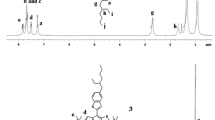Abstract
In order to explore the effect of bulky side chain substituted benzodithiophene (BDT) based polymers on optoelectronic properties, here we have designed and synthesized two new 2D conjugated donor–acceptor (D–A) copolymers P1 and P2 via Stille coupling of 2,3-bis(4-(2-ethylhexyloxy)phenyl)thiophene (BAPT) substituted BDT as (D) unit and 1,3-di(2-bromothien-5-yl)-5-(2-ethylhexyl)thieno[3,4-c]pyrrole-4,6-dione (TPD) or 2,5-ethylhexyl-3,6-bis(5-bromothiophen-2-yl)pyrrolo[3,4-c]-pyrrole-1,4-dione (DPP) as (A) units. The new polymers P1 and P2 showed broad absorption windows with vibronic shoulders indicate π–π stacking of polymer backbones. In addition P1 and P2 showed deep highest occupied molecular orbital (HOMO) energy levels of −5.50, −5.35 eV, respectively which allow delivering high open-circuit voltages (V oc) in bulk heterojunction polymer solar cells (BHJ PSCs). The donor photon energy loss (E g–eV oc) of P1 and P2 are 0.87 and 0.57 which is comparable to the previous reports. BHJ PSCs were fabricated with P1 and P2, and they displayed high V oc of 0.99 and 0.78 V, respectively, with maximum power conversion efficiency of 2.05 and 0.96 % in additive free BHJ PSCs. The polymer field effect transistor mobilities of P1 and P2 are 8.0 × 10−3, 9.2 × 10−5 cm2/V s, respectively.








Similar content being viewed by others
References
Cheng YJ, Yang SH, Hsu CS (2009) Synthesis of conjugated polymers for organic solar cell applications. Chem Rev 109:5868
Chen CC, Chang WH, Yoshimura K, Ohya K, You J, Gao J, Hong Z, Yong Y (2014) An efficient triple-junction polymer solar cell having a power conversion efficiency exceeding 11 %. Adv Mater 26:5670
He Z, Xiao B, Liu F, Wu H, Yang Y, Xiao S, Wang C, Russel TP, Cao Y (2015) Single-junction polymer solar cells with high efficiency and photovoltage. Nat Photonics 9:174
Ye L, Zhang S, Huo L, Zhang M, Hou J (2014) Molecular design toward highly efficient photovoltaic polymers based on two-dimensional conjugated benzodithiophene. Acc Chem Res 47:1595
Huo L, Zhang S, Guo X, Xu F, Li Y, Hou J (2011) Replacing alkoxy groups with alkylthienyl groups: a feasible approach to improve the properties of photovoltaic polymers. Angew Chem Int Ed 50:9697
Kranthiraja K, Gunasekar K, Cho W, Park YG, Lee JY, Shin Y, Kang IN, Song M, Chae KH, Kim BS, Jin SH (2015) Influential effects of π-spacers, alkyl side chains, and various processing conditions on the photovoltaic properties of alkylselenyl substituted benzodithiophene based polymers. J Mater Chem C 3:796
Wang Y, Yang F, Liu Y, Peng R, Chen S, Ge Z (2013) New alkylfuranyl-substitued benzo[1,2-b:4,5-b′]dithiophene based donor-acceptor polymers for highly efficient solar cells. Macromolecules 46:1368
Dou L, Gao J, Richard E, You J, Chen CC, Cha KC, He Y, Li G, Yang Y (2012) Systematic investigation of benzodithiophene-and diketopyrrolopyrrole-based low bandgap polymers designed for single junction and tandem polymer solar cells. J Am Chem Soc 134:10071
Kularatne RS, Sista P, Nquyen HQ, Bhatt MP, Biewer MC, Stefan MC (2012) Donor–acceptor semiconducting polymers containing benzodithiophene with bithienyl subsituents. Macromolecules 45:7855
Kranthiraja K, Gunasekar K, Cho W, Song M, Park YG, Lee JY, Shin Y, Kang IN, Kim A, Kim H, Kim BS, Jin SH (2014) Alkoxyphenylthiophene linked benzodithiophene based medium band gap polymers for organic photovoltaics: efficiency improvement upon methanol treatment depends on the planarity of backbone. Macromolecules 47:7060
Liu Q, Bao X, Wen S, Du Z, Han L, Zhu D, Chen Y, Sun M, Yang R (2014) Hyperconjugated side chained benzodithiophene and 4,7-di-2thienyl-2,1,3-benzodithiadiazole based polymer for solar cells. Polym Chem 5:2076
Liu Q, Bao X, Han L, Gu C, Qiu M, Du Z, Sheng R, Sun M, Yang R (2015) Improved open-circuit voltage of benzodithiophene based polymer solar cells using bulky terthiophene side group. Sol Energ Mat Sol Cells 138:26
Cheon YR, Kim YJ, Ha JJ, Kim MJ, Park CE, Kim YH (2014) TPD-based copolymers with strong interchain aggregation and high hole mobility for efficient bulk heterojunction solar cells. Macromolecules 47:8570
Acknowledgments
This work was supported by grant fund from the National Research Foundation (NRF) (2011-0028320) and the Pioneer Research Center Program through the NRF (2013M3C1A3065522) by the Ministry of Science, ICT and Future Planning (MSIP) of Korea.
Author information
Authors and Affiliations
Corresponding authors
Rights and permissions
About this article
Cite this article
Kranthiraja, K., Park, S.H., Cho, W. et al. New bulky side chain substituted benzodithiophene based 2D-conjugated polymers for optoelectronic applications. Polym. Bull. 73, 2567–2581 (2016). https://doi.org/10.1007/s00289-016-1686-3
Received:
Revised:
Accepted:
Published:
Issue Date:
DOI: https://doi.org/10.1007/s00289-016-1686-3



